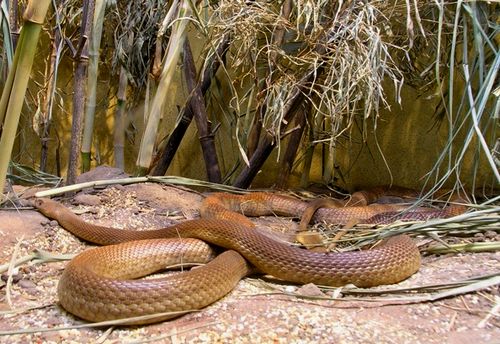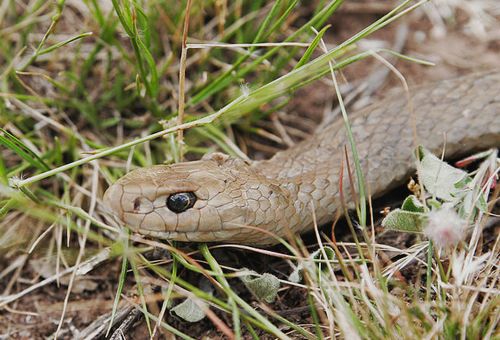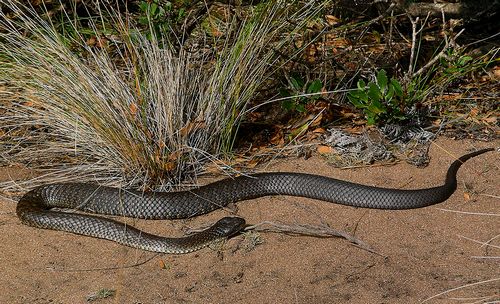 |
| (Not our photo). The Inland Taipan or Fierce Snake reported as the most venomous snake in Australia. |
Yesterday’s Sydney Herald newspaper posted this story we’d also seen on the news throughout the day about a Fremantle woman who was apparently bitten by a snake while on a walk on the beachfront esplanade, a paved boardwalk generally free of high grass and brush.
After being bit, she walked home to her husband showing him the bite, an ambulance was called. She later died at the hospital. (The hospital is yet to confirm that her death is a result of a snake bite until after an autopsy is performed). She had a penetration mark on her foot. Had she not walked home instead, immediately calling for an ambulance, she may be alive today. We extend our deepest condolences to her family.
Then again, we don’t know all the facts and can only surmise based on what’s being reported in the news. Apparently, from what we’ve read online snakes are often seen in the Perth metro area especially as the weather warms.
 |
| (Not our photo). Eastern Brown Snake, purported the second most venomous snake in Australia. |
Paying attention by diligently watching for snakes in high-risk areas has been on our radar these past several years especially after spending so much time in Africa where 3,529 people die each year (or much more unreported) from snakebites as opposed to considerably fewer fatalities in Australia:
|
Australian Snake Bites
“In Australia there are about 3,000 snake bites per year, of which 200 to 500 receive anti-venom; on average one or two will prove fatal. About half the deaths are due to bites from the brown snake; the rest mostly from tiger snake, taipan and death adder. Some deaths are sudden, however in fact it is uncommon to die within four hours of a snake bite.” |
From the World Health Organization (WHO):
“Envenoming resulting from snake bites is a particularly important public health problem in rural areas of tropical and subtropical countries situated in Africa, Asia, Oceania, and Latin America. A recent study estimates that at least 421,000 envenomings and 20,000 deaths occur worldwide from snakebite each year, but warns that these figures may be as high as 1,841,000 envenomings and 94,000 deaths. The highest burden of snakebites is in South Asia, Southeast Asia, and sub-Saharan Africa.
Snake bite is primarily a problem of the poorer rural populations in these regions and affects mainly those involved in subsistence farming activities. Poor access to health services in these settings and, in some instances, a scarcity of antivenom, often leads to poor outcomes and considerable morbidity and mortality. Many victims fail to reach hospital in time or seek medical care after a considerable delay because they first seek treatment from traditional healers. Some even die before reaching hospital. Hospital statistics on snakebites therefore underestimate the true burden.”
With our second highest worldwide readership at this time from Australia, (the first highest from the US), we decided it was important to post this snake bite information from Dr. Struan K. Sutherland, gleaned from published university papers. This comprehensive report appears to be the most highly informational and detailed we’ve found in Australia.
If only one Australian or citizen of other countries learns how to respond to a snake bite from reading this post, our post was well worth the time and effort. For our readers in areas with low risk of snake bites, we’ll be back tomorrow with a more generalized post.
Included in this report is first aid for snake bites as follows and also includes more photos of venomous snakes in Australia:
It is extremely important to retain traces of venom for use with venom identification kits.
Cutting or incising the bite won’t help. High tourniquets are ineffective and can be fatal if released.
The “pressure-immobilisation” technique is currently recommended by the Australian Resuscitation Council, the Royal Australasian College of Surgeons, and the Australian and New Zealand College of Anaesthetists.
The lymphatic system is responsible for the systemic spread of most venoms. This can be reduced by the application of a firm bandage (as firm as you would put on a sprained ankle) over a folded pad placed over the bitten area. While firm, it should not be so tight that it stops blood flow to the limb or to congests the veins.
Start bandaging directly over the bitten area, ensuing that the pressure over the bite is firm and even. If you have enough bandage you can extend towards more central parts of the body, to delay spread of any venom that has already started to move centrally. A pressure dressing should be applied even if the bite is on the victims trunk or torso.
Immobility is best attained by application of a splint or sling, using a bandage or whatever to hand to absolutely minimise all limb movement, reassurance, and immobilisation (eg, putting the patient on a stretcher). Where possible, bring transportation to the patient (rather then vice versa). Don’t allow the victim to walk or move a limb. Walking should be prevented.
The pressure-immobilization approach is simple, safe, and will not cause iatrogenic tissue damage (ie, from the incision, injection, freezing, or arterial tourniquets – all of which are ineffective).
See the AVRU site for more details of bandaging techniques.
This poster from thefirstaidshop.com.au is worth keeping.
Bites to the head, neck, and back are a special problem – firm pressure should be applied locally if possible.
Removal of the bandage will be associated with rapid systemic spread. Hence ALWAYS wait until the patient is in a fully-equipped medical treatment area before bandage removal is attempted.
Do NOT cut or excise the area or apply an arterial torniquet! Both these measures are ineffective and may make the situation worse.
Joris Wijnker’s Snakebite Productions has more information on envenomation and he can supply a suitable first aid kit and booklet.”
Had the above mentioned woman seen this information at some point, she may be alive today. Walking home increased her heart rate and could easily have contributed to having the venom flow through her bloodstream more quickly. The patient should be immobilized until emergency professionals arrive on the scene.
 |
| (Not our photo). The Tiger Snake. |
While we lived in Africa for nine months, much of which was spent in areas with some of the world’s most venomous snakes are found, we made every attempt to educate ourselves immediately upon arrival.
An important aspect of snake safety is STAY AWAY. Many snakes will not provoke an attack and often bite when aggravated or stepped on. Many reported fatalities are attributed to foolishly trying to kill or handle a snake.
The number to call in Australia if you find a snake in your yard or home is Wildcare Helpline: (08) 9474 9055
One may think we’ve had little exposure to venomous snakes. However, we actually had a personal encounter with the extremely dangerous Mozambique Spitting Cobra in South Africa that fell from the ceiling on our veranda landing next to Tom’s bare feet while we were sitting near each other busily distracted while working on our laptops.
For our personal story and photos of a Mozambique Spitting Cobra experience on our veranda, please click here.
Over these past few days, we’ve focused on recent news stories we’ve gleaned from TV news, all relevant in our travels in one way or another. Soon, in less than three weeks, we’ll be living in Fiji without a TV and be reliant upon online news. We both have auto flash messaging that pop up on our laptops from various news sources worldwide, enabling us to stay well informed.
When traveling the world, we’ve found it vital to stay informed as to world affairs, including political unrest, wars, natural disasters, health-related events, weather-related issues, and financial chaos as in what recently occurred in Greece, all of which may have a huge impact on our travel to a specific location.
We continue to exercise caution and practicality interspersed with an ongoing passion for a certain degree of excitement and adventure commensurate with our interests, abilities, and desires as we continue to explore the world.
Stay tuned for more…
Photo from one year ago today, August 19, 2014:
 |
| The busy streets in South Kensington made us thrilled that we could travel almost everywhere we wanted to go on foot. For more details, please click here. |
